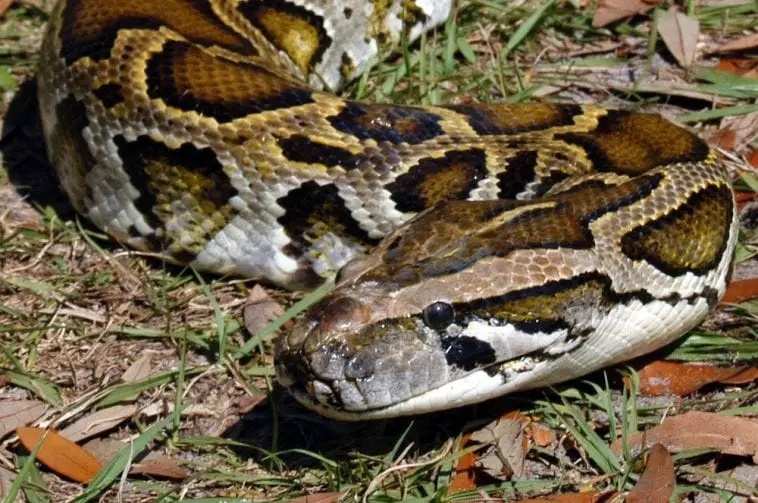Scientific Facts
| Common Name: | Burmese Python |
| Scientific Name: | Python bivitattus |
| Life Span: | 20 to 25 years in captivity |
| Size: | 16 to 23 feet |
| Habitat: | River valleys, rainforests, woodlands, grassy marshes, scrublands, semi-rocky foothills |
| Country of Origin: | Southeast Asia |
Physical Description
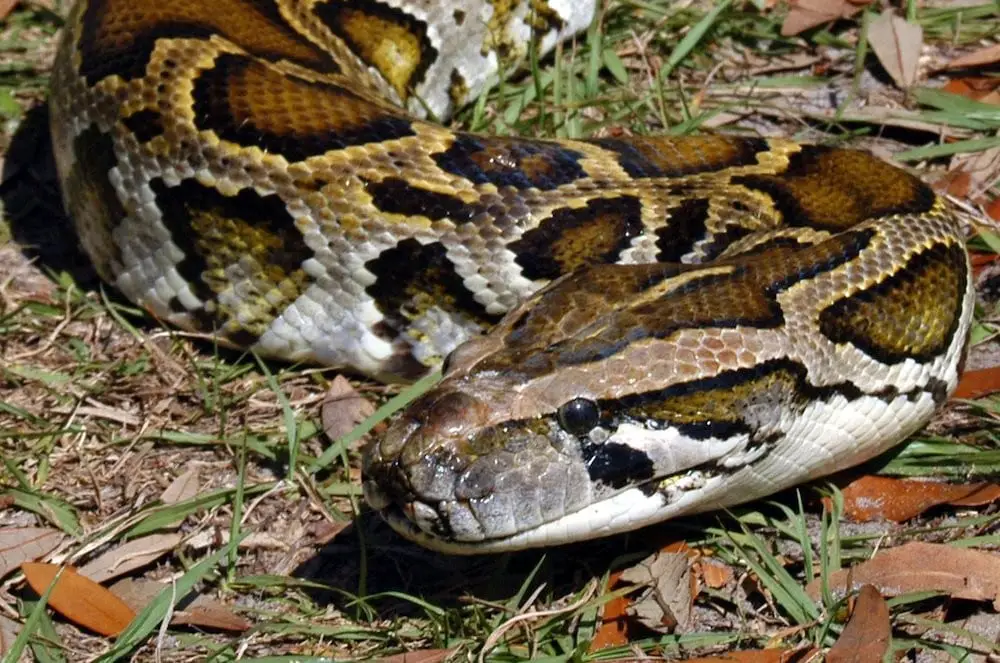
Burmese pythons are big snakes. They ranked as the top 6 in the list of the largest snakes living on Earth. They have dark-colored scales with a light gold or cream borders and brown or reddish blotches from head to tail. These patterns look the same with the ones on giraffes.
These snakes are constrictors. They don’t have fangs. Instead, they have back-curving teeth which they use in grabbing prey.
Those Burmese pythons living in their natural habitats are usually less than 12 feet long. They can grow up to more than 13 feet, but it does not happen all the time. However, Burmese pythons may likely grow longer than their usual length if they are captive animals. Records say there was a Burmese python that grew up to 18 feet and 10 inches long.
Size
Burmese pythons can grow up to 20 feet or even longer. Considering their size, they may weigh more than 250 lbs. However, these are unusual. Burmese pythons often don’t reach those proportions quickly and even by accident. Their growth is quite rapid at the beginning, which will eventually slow down.
Habitat
Burmese pythons are commonly found in Southern and Southeast Asia. They exist in the swamps, jungles, and grasslands. The young snakes are often in the trees, but as they gain weight, they start to live on the ground. These snakes need a water source. They are good swimmers as they can hold their breath for up to 30 minutes.
Development
The young Burmese pythons are precocial when their eggs hatch. The babies become independent right after hatching. These young snakes will be sexually mature after 2 to 3 years. They need to reach the ideal body weight to become ready for mating.
Life Span
Like other reptiles, Burmese pythons can also live for decades. On average, they can live for up to 25 years. The oldest recorded snake lived reached the age of 28 years and 3 months.
Varieties and Morphs
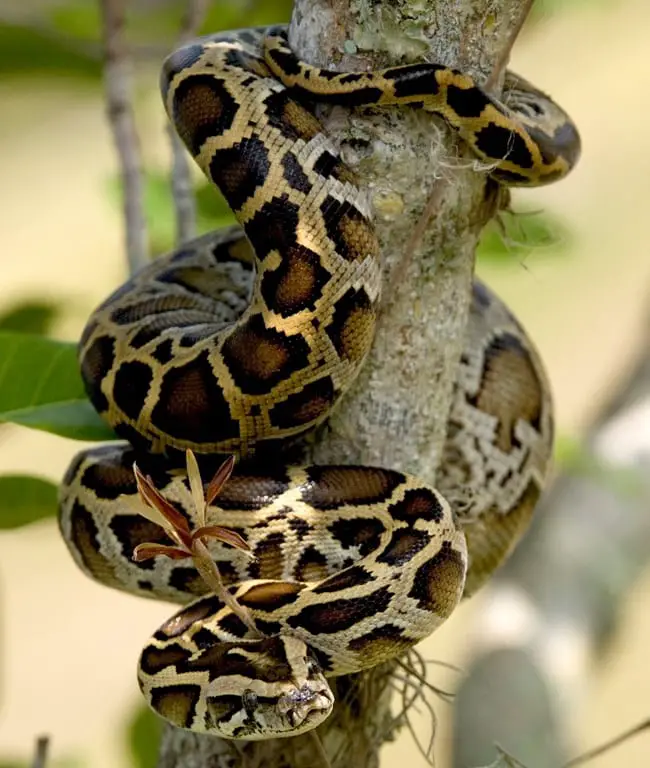
While the Burmese pythons are large snakes, they are among the commonly sold species. Burmese pythons are also one of the most beautiful snakes. The following are the most common Burmese python varieties and morphs:
Green or Patternless
Young patternless and green Burmese pythons might retain the pattern fragments. However, these patterns will eventually become a uniform washed-out brown or khaki or dark green as the young snakes grow into adults.
Albino
Usually, albino Burmese pythons are white, yellow, and orange. The real albino does not have a pigment, in which they have red and yellow pigments. They just don’t have black pigments. The young albino snakes have bright red eyes and white base hue topped with red and yellow marks. These marks will be less distinct as they grow old.
Labyrinth
Labyrinth Burmese pythons have varied and broken maze-like patterns and strips on the 1st quarter of their bodies.
Granite
These Burmese pythons look great with their light tan heads that can also have a washed-out brown spear-shaped pattern. Their bodies have fine and intricate granite-look patterns.
Dwarf
Although it is not essentially a color morph, the dwarf Burmese pythons often remain at the manageable size. Their length is typically between 5 and 7 feet.
Diet and Feeding
Burmese pythons are healthy eaters. If you want to own a Burmese, you need to secure first a stable food source for the animal. The growth rate for Burmese pythons depends mainly on the feeding regimen.
Whether you’re raising these snakes for breeding or not, you need to use and follow the correct feeding regimen. Power feeding these snakes at the age of 2 or 3 leads to a quick growth that has good and bad points.
Whatever you do when feeding them, you should cut back on the feeding schedule as their growth starts to slow down. This will help a lot in preventing them from getting obese. Feed the hatchlings with baby mice in the first few feedings before you start giving them adult mice. Although every snake is different, you can follow these general rules in feeding Burmese pythons:
- From hatchlings to 4 feet, feed them with 1 or 2 appropriately-sized mice every 3 to 4 days.
- When the babies are already 4 feet long, start giving them medium-sized rats, then switch to bigger rats.
- When reaching the sexual maturity stage, feed them with 1 to 2 prey animals every 5 to 7 days. At this stage, the female snakes are 10 feet long while males are 8 feet long.
- By 6 to 7 feet, you can start giving them 3-pound rabbits. Increase the rabbit’s size while your pets grow.
- From the sexual maturity stage (approximately 18 months) to 3 years, you must feed the snakes with 1 to 2 rabbits once per week.
- From 3 years onwards, feed them with 1 to 2 rabbits every 10 days, adjusting the schedule, depending on the overall appearances of your pets.
Feeding your Burmese pythons safely is important. When your pets are longer than 6 feet long, you must follow the procedures of safe feeding to avoid injuries. The guidelines will include having prey within reach, feeding one Burmese python per enclosure at a time, and feeding them by using a shield, snake hook, and wooden board which acts as the buffer when eliminating uneaten prey. Feed your pets with pre-killed prey animals because they can probably injure your pets by clawing and biting if they are alive. For rabbits, you can ask the supplier to slay the rabbits during your purchase.
Burmese pythons like to eat any type of fowl. They love chicken (whether live or raw and whole), however, fowl is only the last meal option for fattening those snakes that are hesitant to feed. Fowl of any type can significantly increase the weight of Burmese pythons, which is why they should not be your top choice in feeding your pets.
If you plan to buy food supplies in a large quantity, you may buy pre-killed frozen prey animals and keep them in the fridge. You need to melt these frozen goods before giving them to your pets.
Behavior
Burmese pythons are gentle snakes, which is one of those reasons behind their popularity. Hatchlings can be a bit nippy, but they will eventually settle down and stop with gentle handling.
Other young snakes may squirm away, bite several times, and defecate if restrained. Some are offensive regardless of how careful you are in handling them.
Tameness is a crucial characteristic of your new pet. Therefore, be wiser in choosing your Burmese pythons.
Common Health Problems
Keeping Burmese pythons healthy and happy is quite easy. These snakes are considered hardy captive. However, heat provision is a crucial husbandry practice which makes a big difference between life and fatality.
Burmese pythons will stay alive within the mildly sub-standard heat with good care. However, a dramatic or chronic lack of warmth can suppress their immunity. When that happens, your pets become vulnerable to various health problems.
#1. Respiratory Infections
Respiratory diseases in Burmese pythons are common but preventable. Most cases of respiratory infections in reptiles are due to insufficient heat gradients within the enclosure. In the early phases of these diseases, the snakes may wheeze while breathing or lift their heads.
Burmese pythons suffering from advanced respiratory infections will produce a foamy substance through their mouth and pouching of their lower throat. Contact the veterinarian quickly as soon as you notice this secretion in your pets.
When detected early, the treatment will be successful. You can address the disease by just giving the ideal heat gradient. If not treated as soon as possible, the snakes will need reptile-safe antibiotics and complete veterinary workup.
#2. Inclusion Body Disease
Burmese pythons fall in the same category as boa constrictors. Boas are known to be the main host for a severe reptile ailment called IBD or Inclusion Body Disease. IBD is a retrovirus infection like AIDS. People can’t acquire this disease from Burmese pythons, but they can transmit the infection to other snakes.
Keep in mind that Burmese pythons are highly susceptible to IBD and other viral infections. Historically, those snakes with exposure to the virus dramatically died in just a few weeks. The signs of Inclusion Body Disease include seizures, tremors, loss of eyesight, and loss of tongue control. The symptoms also include being unable to turn itself right when you turn it upside down (a condition known as the “stargazing syndrome”.
IBD exposure occurs when the infected reptiles have mites, and those mites transfer the contaminated body fluids to others during the breeding season. Also, it can happen when you leave your pets exposed to the contaminated specimens. Therefore, you should avoid housing another boa constrictor species in one cage with a Burmese python.
#3. Burmese Python Disease
Burmese pythons are the main snake species affected by the BD or Burmese Disease. However, the Borneo short-tailed pythons, Africa rock, and blood pythons seem vulnerable to this disease, too.
Burmese Disease is a slow and progressive condition characterized by the recurring attacks of respiratory infections such as pneumonia and the participation of opportunistic bacteria. BD is annoying especially in the herpetoculturist community since there’s little to zero definitive information regarding the methods or causes of transmission.
Researchers noticed the similarities between IBD and BD. However, they are uncertain if BD is the new strain of retrovirus or not. Infected snakes must be treated and quarantined immediately. Euthanasia becomes the last option in advanced cases.
#4. Scale Rot (Necrotizing Dermatitis) and Blister Disease
These health issues are often the outcome of bad husbandry practices. These conditions can occur at the same time. Blister disease develops as a result of the seriously inadequate hygiene while scale rot is due to the breakdown of the snake’s immunity.
Snake scale diseases could have symptoms which range from the mild hemorrhage to serious ulceration and blistering. The result is like the chemical burn, forming painful blisters that can take weeks to heal.
Reproduction
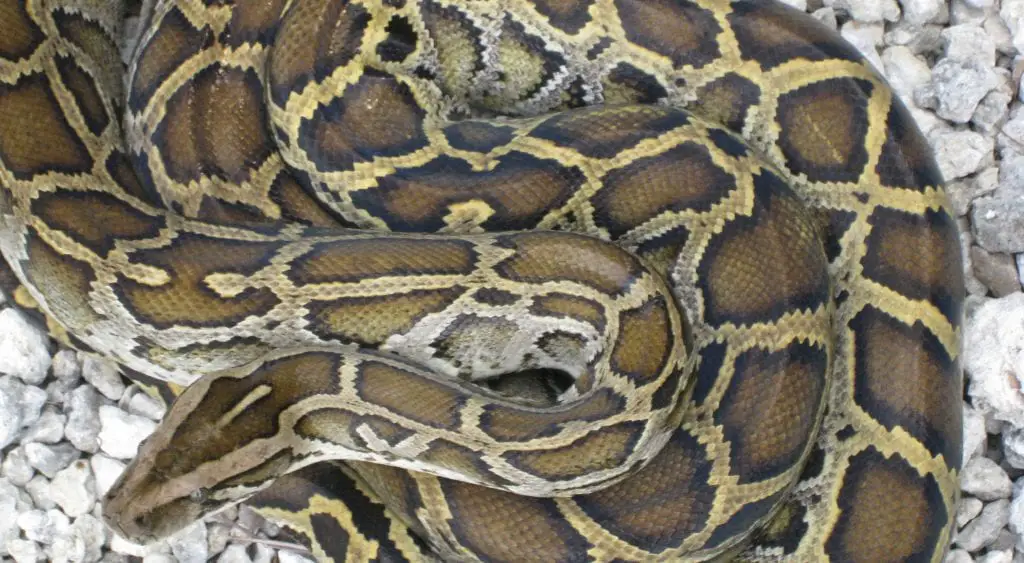
When mating, male Burmese pythons wrap their bodies around the females. Then, they will flick their tongues all over their mates. They will do that several times to entice the females to mate. Copulation will last between 5 and 30 minutes. The females are expected to lay their eggs 3 to 4 months after copulation.
Africa rock and blood pythons are oviparous species of snakes. Their breeding season lasts from November to February. The female snakes will lay their eggs in March to April. The incubation period lasts from 60 to 80 days.
The females will not eat as they wrap themselves all over the eggs. With muscle strain and contractions, they can maintain adequate temperature for the eggs. They can do that despite being ectothermic.
Every egg clutch consists of 12 to 36 eggs. However, they can lay up to 100 eggs. The hatchlings will measure 18 to 29 inches in length and weigh approximately 4 ounces. The young Burmese pythons will be sexually mature at the age of 2 or 3.
Distribution
Burmese pythons tend to stay in tropical regions and enjoy being near the water. These snakes are semi-aquatic. They also stay in the trees. Burmese pythons are more common in Eastern India, Southeast Asia, China, and Cambodia.
They strongly need water, so they should be close to a water source. They can live and thrive in the woods, savannahs, and even in the rocky areas for as long as food and water are available. Many of them are found living in the Florida everglades.
Conservation or Threats
Humans are a threat to Burmese pythons. Their depleted habitat, the continuous demand for them in exotic pet sale, and the need for their flesh and skins were the reasons why these snakes fell into the list of endangered species.
Ecosystem Role
Burmese pythons eat a wide array of rodents and vertebrates. It might be crucial in controlling the populations of some prey species.
Caging
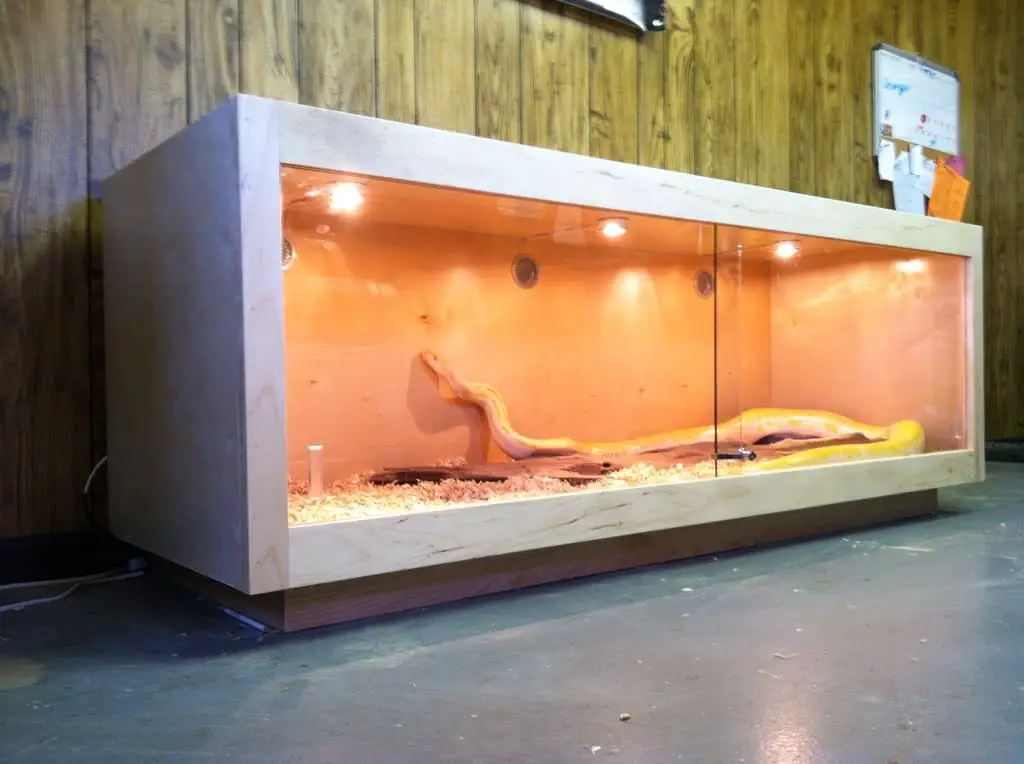
Young Burmese pythons are okay with a 55-gallon tank. However, while they grow, they will need a bigger and tougher enclosure. After the first few years, your options will include the custom-made cages crafted using Plexiglass and wood. You can also modify a big room or closet for your pets.
Burmese pythons are great in escaping. They are extremely strong, so their housing should be huge enough. Give them a big enclosure that should be at least 4 feet wide and 8 feet long. Also, the enclosure should be secure and strong.
Most importantly, the cage of your Burmese pythons must keep the snakes safe and comfortable. After all, the subsequent requirements will be less important when the snakes have disappeared into the hole within the wall behind your washing machine as you forgot the secure it properly.
The enclosure’s size must be big enough to let the snake move inside with freedom. However, a small enclosure helps acquire and maintain accurate humidity and temperature control.
For young Burmese pythons, a half log or any other hide box that you can buy from a pet store will be a good choice. Even the cardboard box would do okay for young pets. However, as the snakes grow, you will need to be more artistic.
The storage bins made of plastic are excellent hides for bigger snakes. Just make an access hole on one side, and make sure there are no pointed edges. Put a humidity retreat, which is so essential when your pets are shedding. You can put wet sphagnum moss in the hide.
Burmese pythons are earthly snakes that love to stay on the ground. Therefore, you should consider the floor space of their enclosure. The floor space would be more important for your pets, instead of the enclosure’s height.
The baby Burmese pythons will need a space that is equal to 10-gallon reptile terrariums. Bigger snakes will ask for more space. Those snakes weighing 200 pounds will require a floor space that measures 8 feet long and 4 feet wide. Consider providing your pets with an enclosure with a big floor space that is 4 to 6 times the space occupied by the snakes in the flat coil pose.
Also, make sure the enclosure has a door which allows quick access and easy, secure closing. A glass or Plexiglass window for viewing will be important, too. Burmese pythons may also want some sort of ventilation, though it is not as much as what you might be thinking. Humidity and heat can easily escape through the vents, particularly through those vents positioned on top of the cage.
Tiny vents on the sides of the enclosure are enough. They allow sufficient air exchange. Glass, plastic, and wood are acceptable materials used in making an enclosure for Burmese pythons. An enclosure made of ABS plastic is an excellent option as it comes with a smooth and nonporous texture that allows quick cleaning or sterilization.
Snake habitat products, on the other hand, can make it more difficult. So, simplicity is a good idea in some instances.
The enclosure of your Burmese pythons should have rounded edges and corners, leaving no areas that can be troublesome to clean. Also, this enclosure has to be lightweight with huge viewing areas equipped with tempered glass. Regular spot cleanings will be necessary with the ideal supplies intended for reptile cleaning.
Substrate
The market now has so much more to offer when it comes to substrates. You can give a naturalistic vivarium for big pythons with the use of only the sturdiest materials.
Substrates should be picked for utility instead of aesthetics. Newspaper is fairly sterile, absorbent, and widely available. various wood types, shavings, including the shredded substrates are usable, too. However, these materials are not so ideal for humid environments.
For the hatchlings, you can use unprinted paper or paper towels in lining the enclosure. These materials are easier to clean, making it less difficult to check your pets’ health from time to time.
If your snakes are bigger, you can use outdoor/indoor carpeting for them as it is easier to maintain. Just have some pieces available and put them there when you need to clean and sterilize the enclosure. Linoleum is a pretty choice as well for big snakes because it’s easy to clean and sterilize.
Lighting and Temperature
The best temperature for growing Burmese pythons is anywhere between 85 and 90 degrees Fahrenheit. However, constantly maintaining the temperature all over the cage can be daunting. You can use electric thermometers and combine them with the alarms that may go off if the temperature drops under the specific level. These materials will help you a lot to maintain the correct temperatures.
The greatest system for sustaining the correct temperatures within the cage of your snakes involves maintaining the daytime air temperature between 84 to 88 degrees Fahrenheit with a space for basking that reaches the ideal surface temperature between 88 to 92 degrees Fahrenheit.
In the evening, you can drop the temperature between 80 to 84 degrees Fahrenheit. Always make sure the enclosures of your Burmese pythons have basking areas. This will help a lot in protecting your pets from those health problems associated with too low temperatures.
Also, you have many options to consider in terms of heating systems, but you should keep in mind that big snakes need to have the chance to regulate their body temperatures on their own. You can make it happen by having a part of the cage surface set in a temperature between 88 to 90 degrees Fahrenheit.
Regardless of what heat choice you prefer, be extra careful and see to it that there no exposed heat factors that can burn your pets. Here are your top choices for a heat source:
Heat Tapes and Pads
By far, it is the simplest way to heat the enclosure. Just be sure you keep them connected to temperature probes and thermostats.
Pig Blankets
These plastic-covered heating pads are available as special orders through the feed shops. These are commercially produced heating models for huge reptiles like Burmese pythons. They are big and stiff plastic-enclosed models which produce high surface warmth over the wide areas. Pig blankets can be controlled by using the most suitable thermostats.
Ceramic Heaters
These make for the best source of overhead heat. Just be sure you choose the best wattage bulb that fits the length and width of your pets’ cage. Also, the ceramic base should be able to manage the wattage.
Plastic sockets equipped with the cardboard liners may burn after some time. Like any other heat sources, thermostats or rheostats are necessary.
Incandescent Lighting
These lights are ideal for keeping your Burmese pythons warm. Be sure you measure the temperature in the basking spot immediately under the fixture and at the space furthest from the light an hour after you turned on the bulb.
Incandescent bulbs should be on the exterior of the cage wherein the light cannot burn your pets.
Room Heaters and Space Heaters
If you have a large collection or you have a special snake room, then you must use space heaters. However, you must be more careful not to let these heaters overheat and harm your pets.
Hot Rocks
While the hot rock heaters can pose issues when the snakes curl all over the rocks and burn themselves, hot rocks can help raise the hatchling Burmese pythons. Just be extra careful as the snakes don’t quickly realize they are on the heater rocks. By the time they learned they are on them, the heat rocks already burned them or cause an ulcer on their bodies.
Humidity
Burmese pythons also need humidity but not much of it. Typically, the humidity level within their enclosure should stay around 50 and 60 percent. Always give your pets a bowl of water. This bowl should be big enough and can accommodate your snakes. This way, they can take a bath in it if they want to. Just a quick spray on the enclosure every few days would also help in maintaining the ideal humidity level.
Shedding

Burmese pythons may shed their skin occasionally a few weeks after they come out of the eggshells. The frequency of this process depends on the growth rate for all Burmese pythons. Sometimes, they shed once or twice within a year.
Handling
Although Burmese pythons are usually scared of humans because of their high stature, special care will still be important in handling them. In the wild, pythons typically avoid humans whenever someone came across them. However, there are ways to handle them correctly.
The bigger and longer a snake is, the heavier it is. Adult Burmese pythons are too heavy for one person, so there should be multiple handlers. The number of needed handlers depends on the length and weight of the snake.
Some regions require the Burmese python owners to obtain special licenses. As with any other wild animals being kept as pets, treating them with care and respect is a must.
Possible Danger to Humans
Usually, people who like Burmese pythons lose their eagerness in taking care of them. Having these snakes as pets can also turn into a problem once they grow too long and heavy. Taking them out and bringing them back to the enclosure becomes more challenging in this case. Owners who got tired of taking care of their pets prefer to set these snakes free to the forest where they can eventually become an issue.
On the other hand, Burmese pythons are not so horrible animals because they are non-venomous. They don’t have fangs. However, they tend to attack and bite anyone if they feel threatened.
If someone attacks them, the snakes will wrap their bodies to the person and try to kill him with a tight squeeze. If you got a bite when handling your new pet, don’t forget to seek medical care right away. This will help prevent the spread of any possible infection caused by the bite.
Where to Get One?
Burmese pythons are widely available in various patterns and colors with new qualities or trait combinations. They are easier to get from the captive breeders or online reptile shop. But, before you buy one, check the local laws or regulations about the species. Once you’re ready, follow these tips to get the best pet for you:
- Ask the handler to measure the snake’s temperament and health. Baby Burmese pythons can be quick and a bit nippy. They may hiss as well, but their behavior will change with regular proper handling.
- Observe the snake physically. Check the skin of the animal. Make sure it is firm and taught. The scales should be smooth while its eyes should be bright. The vent must be clear from fecal strains.
- A healthy burn must move easily. Also, there should be no clicking, and the snake must not be hissing or wheezing every time it breathes. Likewise, the animal must have a straight, well-aligned spine.
How to Care for a Burmese Python?
With their size, Burmese pythons are not ideal reptile pets for novices and intermediate snake owners. Every owner needs to fulfill some requirements before buying a big snake like this. You have to answer these questions:
- Is owning a big constrictor suitable to your lifestyle?
- Do you have small pets or kids?
- Can you handle an adult Burmese python even when it weighs more than 100 pounds?
- Are you prepare for a long-term commitment to taking care of a reptile?
Taking care of Burmese pythons is a great experience for a reptile lover. It is a long-term commitment, considering their long lifespan. These snakes can stay with you for decades.
As they grow old, their length stretches and weight increases. In the end, you will need someone’s help in carrying your pets.
Of course, you need to make them happy. For that, you must provide whatever the snakes need – food, water, a comfortable and spacious enclosure, warmth, humidity, and so on.
If you want to own a Burmese python but you’re worried about how big and heavy it can become, then consider dwarf Burmese pythons. They are easier to handle than the other types of Burmese pythons as they don’t grow longer and heavier.
Fun Facts about the Burmese Pythons
- The Burmese pythons are among the biggest snakes in the world.
- They are non-poisonous snakes, but they may bite as a form of self-defense.
- They are solitary animals but may come together with one another to mate.
- The female Burmese pythons incubate their eggs by twitching or contracting their muscles fast, like what a person does when he shivers.
FAQ
Are Burmese pythons friendly?
Burmese pythons are usually and may not be friendly. Hatchlings could be uneasy but can be tamed with consistent, gentle handling.
Can a Burmese python swim?
Yes, a Burmese python can swim. They are great swimmers as they can stay into the water for 30 minutes before they rise to breathe.
How quickly do Burmese pythons grow?
Burmese pythons are fast-growing snakes. They can double their length in a few weeks and reach 6 feet in the first 6 months of their lives.
Can Burmese pythons harm people?
Burmese pythons are non-venomous snakes, and they pose minimal threat to humans. However, they can bite, wrap their bodies to a person, and kill the person.
How often do Burmese pythons breed?
The breeding season for Burmese pythons happens in the early spring. At this season, Burmese pythons may become aggressive, especially the males.
Do Burmese pythons like to have a companion?
Burmese pythons are born to be on their own. They spend most of their time alone, but you will see them in pairs during the breeding season.
When do Burmese pythons lay eggs?
After the mating process, the female Burmese pythons will lay clutches of 12 to 36 eggs. Expect your pets to lay her eggs in March or April.
How long does it take for the eggs of Burmese pythons to hatch?
This will happen in 60 to 90 days from the time the mother snakes laid their eggs. The incubation period takes around 2 months after the hatchlings appear.
What do Burmese pythons like to eat?
Burmese pythons are meat-lovers, so you can give them rats, mice, and rabbits. You can also give them birds or chicken, but it has to be in moderation to prevent excessive weight gain.
How do wild Burmese pythons look for food?
Burmese pythons look for food by using their pointed teeth to grab and seize the prey. Since they don’t produce venom, they constrict their victims and bring them to death.
What are the natural enemies of Burmese pythons?
The babies and young Burmese pythons can become victims of wild dogs, birds, hyenas, large insects, large frogs, spiders, or even other snakes. Adults can also be in danger when surrounded by larger birds, leopards, and lions.
What’s the role of Burmese pythons in the ecosystem?
Burmese pythons have a major impact on the ecosystem. They kill the rats and other smaller pests that may carry diseases and transfer them to humans.

